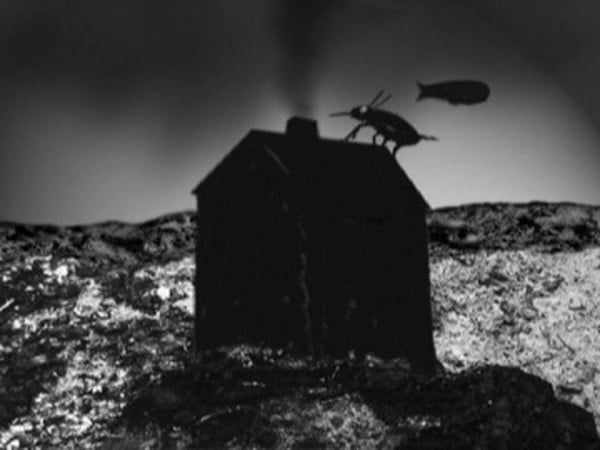Eye For Film >> Movies >> Dynamic: 01 - The Best Of DavidLynch.com (2007) Film Review

On one of the extras on Dynamic: 01, in a video response to a question sent in by a DavidLynch.com subscriber, the director reveals that instead of keeping a journal, he has a box full of random ideas that he scribbles down all the time on scraps of paper, in case they should prove useful for subsequent inclusion in his grander projects.
The six short films and three 'intervalometer experiments' collected here, comprising the pick of the audiovisual works he has created for, and posted on, his subscription-only website, feel quite a bit like those Sibylline notes – inchoate jots, rough sketches and fragmentary dry runs for a bigger picture that we never quite see. These are glimpses deep into the innermost gears and cogs of Lynch's ideas-machine, even if their very imperfection brings with it a certain disappointment.

It is hardly a coincidence that the longest piece here, Lamp (30 minutes), documents Lynch's gradual construction (from metal, fix-all and paint) of a lighting fixture that he does not quite complete. It is all at once a hands-on masterclass in the plastic arts, conducted amiably by Lynch as though he were a celebrity chef sharing with his viewers a practical recipe (for organic two-tone lampposts), and also a laying bare of an artist's creative impulse and of the labours (not to mention coffees and cigarettes) that fuel it.
No coincidence either, then, that the product, if and when finished, will be a source of light. Lynch emphasises the hard work, discipline, experimentation and patience required to achieve the beauty of illumination, even as he suggests that it is something we can all ultimately do, step by step, if we equip ourselves with the right tools and protective gloves. Fortunately there is also a fold-out urinal of Lynch's own design built into the workshop's basin, in case, in his pursuit of aesthetic perfection, he should also need to attend to his bodily needs. Lamp may at first seem banal, even guileless, but it is a surprisingly rich lesson in the spiritual and material aspects of both art and life.
Other shorts here trace the opposite journey, from light to darkness. Boat (seven minutes) is essentially a home video of Lynch taking a trip in his motorboat, named Little Indian. However, it acquires a more metaphysical dimension thanks to the addition of a bass-heavy soundtrack of dark ambience, a disorientingly abstract voice-over by Lynch's wife Emily Soffle, and the director's assertion at the outset: "We're gonna try to go fast enough to go into the night." Similarly, the 'intervalometer experiments' use the timelapse feature on Lynch's camera to reveal, respectively, a valley, a concrete staircase, and the view from a window, all magically transformed by the gradual encroachment of shadow.
The Darkened Room (10 minutes) begins with Etsuko Shikata breezily showing off her Tokyo apartment and reeling off facts about bananas, before declaring: "I have a friend. My friend is sitting in a darkened room. My friend's crying. Do you see her? I cannot see my friend." At this point, it all goes a bit INLAND EMPIRE (which is to say, bananas), as we are suddenly transported to that titular space, watching the blonde friend (Jordan Ladd) weep mascara on a sofa while a brunette woman (Cerina Vincent) remonstrates with her menacingly about a mysterious hole in her slip and "what really happened". It is creepy precisely because we have no idea what is really happening ("Any clues?", the brunette asks aggressively), or how to link the cheeriness of the introduction to the abusive oppression of the main sequence. It is the closest thing on this disc to what might be called 'vintage' Lynch.
The black-and-white Out Yonder – Neighbor Boy (10 minutes) shows a side of the director for which he is less widely known: his love of subverting the conventions of situation comedy, as seen in his wildly varied shorts The Cowboy And The Frenchman (1988), Rabbits (2002) and the animated Dumbland (2002). Neighbor Boy is the first of what was to become an online series of Out Yonder scenarios, in which a pair of father-and-son rubes (played by Lynch and his son Austin Jack Lynch) pass tortuously solecistic comment ("this be's bein' somethin' makin' me near anger", etc) on the bizarre people and things that they can see (and we cannot, save for the odd animated shadow) from the vantage of their outdoor chairs – in this case, their giant, milk-hungry neighbour and a violent battle between the ninth cavalry and Indians.
It is absurd, to be sure, but the one-joke note long outstays its welcome. Perhaps that is the point, as we discover ourselves to be no less droolingly gormless as viewers than the yokel Beavis and Butthead before us (who are themselves confronted by the spectacle of an outsized monster).
All these films have been shot on the consumer-end DV to which Lynch has recently wedded himself, only adding to the impression that they are amateurish (if artful) home movies – and the two animated pieces included are similarly rendered in the most basic flash-style cartoonery. Industrial Soundscape (10 minutes) has at its centre a moody black-and-white still photograph of a demolished oil tank that had, when previously standing, served as one of the exterior sets for Lynch's debut feature Eraserhead (1977), while computer-generated hammers and pistons have been superimposed on this desolate terrain to pound out the regular rhythm of the accompanying industrial soundtrack, as the sky flashes ominously behind.
If we are honest, Industrial Soundscape is little more than a primitive music video based on a looped piece of animation, but then, both the type of landscape and the type of musique concrète that it celebrates could reasonably be (re)claimed by Lynch as his very much his own signature, since his pioneering use of them in Eraserhead - arguably to become the origin and inspiration for the whole industrial subculture. Indeed, Lynch's brooding, dark ambient scores are a standout feature of this disc, where the quality of the image is often subordinated to that of the sound. Still, Industrial Soundscape does seem something of a step backwards, in visual, conceptual and even aural terms, from the breakout film whose stifling atmosphere it revisits.
Much better is The Bug Crawls (5 minutes). Like everything else on Dynamic: 01, this black-and-white animated short is just an experimental doodle, but it manages to evoke a whole hidden world just beyond what can be (barely) seen on screen. As a blackened blimp passes overhead, the silhouette of an enlarged beetle scrabbles noisily over a darkened house before falling onto its back, and then the door of the house swings opens to reveal an intense, arcing light whose source remains unknown. It is a Kafkaesque nightmare where the tension is tangible.
In his video introduction to The Bug Crawls, Lynch comments: "I don't know what the rules are there, I just have started, y'know. I'd like to go into that world again." It is exactly that sense of something presented merely in embryo, but full of suggestion and possibility, that marks most of the material in this collection. Whether that delights, or merely frustrates, will vary with individual viewers – but no fan of Lynch will be able to resist peering into this box of half-formed ideas.
Reviewed on: 11 Sep 2009


















